|
|
Argolida
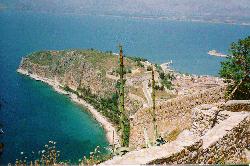 Argos: (20,700
inhab.) Argos today is a mid-size, quiet town that sits on the
edge of the plain of Argos (described by some guide books as
"a rather shabby market town). The modern city lies
at the base of the two large hills, Larissa and Aspis, and
covers the site of the ancient city. It is a common stopping point
for buses from Mycenae to Nauplio, though you normally
wouldn't have to switch here. The bus stop is on the edge of
the large and open town square and it is a pleasant place to
spend a few minutes waiting on the incoming passengers.
Argos: (20,700
inhab.) Argos today is a mid-size, quiet town that sits on the
edge of the plain of Argos (described by some guide books as
"a rather shabby market town). The modern city lies
at the base of the two large hills, Larissa and Aspis, and
covers the site of the ancient city. It is a common stopping point
for buses from Mycenae to Nauplio, though you normally
wouldn't have to switch here. The bus stop is on the edge of
the large and open town square and it is a pleasant place to
spend a few minutes waiting on the incoming passengers.
There is
plenty to see of archaeological interest too. The most
prominent site is the huge classical
theater
- no one has to pay here - where occasional performances are
infrequently staged. The theater stretches up a very steep
hillside and parts of the stage still remain. Many renovations
occurred during the Roman period and there is also the remains
of a large Roman Bath
still standing to its original roof height at places - can't
miss it. Mosaics on the floors can still be seen and
there is even some sarcophagi visible down in a lower level of
the bath. Also see if you can find the remnants of the
hypocaust heating system below the floors of some rooms.
The Ancient
Agora is not readily accessible, but you can wander around the edge of
the theater to see some more Roman remains, including a small
odeion.
If you're in Argos and you have a little time, they also have
a very nice, but small,
archaeological
museum which houses finds from Argos and the nearby site
of
Lerna.
The museum has some great mosaics outside, which have the
months personified. Also of note are the krater fragment
depicting Odysseus and the Cyclops
- at another exhibition when I was there!! - as well as an 8th
cent. B.C. bronze suit of armor.
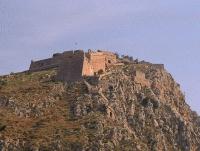 Nauplio:
(10,609 inhab.) Nauplio, the first capital of liberated Greece (from
1829-1834), has a great little town square and some good
restaurants, as well as a decent, small
archaeological
museum. The
museum is located on the second floor of a Venetian arsenal
and houses items from Mycenae, Tiryns, Dendra,
Asine,
Halieis,
and of course Nauplio, which served as the naval base of the
Argives in archaic and classical times. Some of the more
notable items include a bronze cuirass and a helmet made of
boars' tusks - not matching, and
numerous pottery displays (including the clay figurine
depicted here).
The
Castle of Palamidi at Nauplio is quite high but worth the
climb once you get to the top (999 steps!). It looks
impregnable, and it was designed by LaSalle in 1711, but in
battle it fell after only an eight day seige. Nauplio:
(10,609 inhab.) Nauplio, the first capital of liberated Greece (from
1829-1834), has a great little town square and some good
restaurants, as well as a decent, small
archaeological
museum. The
museum is located on the second floor of a Venetian arsenal
and houses items from Mycenae, Tiryns, Dendra,
Asine,
Halieis,
and of course Nauplio, which served as the naval base of the
Argives in archaic and classical times. Some of the more
notable items include a bronze cuirass and a helmet made of
boars' tusks - not matching, and
numerous pottery displays (including the clay figurine
depicted here).
The
Castle of Palamidi at Nauplio is quite high but worth the
climb once you get to the top (999 steps!). It looks
impregnable, and it was designed by LaSalle in 1711, but in
battle it fell after only an eight day seige.
There is a
beach and you can take a boat out (5 min.) to the island
fortress, Bourdzi, where the wildflowers growing from
the walls of the building are quite stunning. Try taking
a walk around the promontory, Its Kale, on the path just above
the water's edge. Also in Nauplio, though I didn't go
there, is the
Peloponnesian
Folklore Foundation. You can also catch a bus to
almost all the other sites in the region from here. Some
big cruise ships put in here with day trips to Mycenae or
Tiryns or even Epidauros. For some strange reason, I had
even better phone connections while I was there than in many
places in Athens. Cheaper and fresher fruit than in the
cities can be found here too.
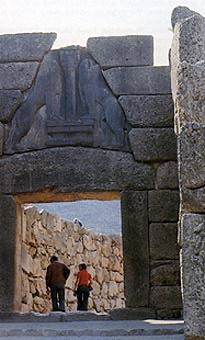 Mycenes:
The
oldest archaeological findings from Mycenas are dated around
3000 BC. However, during the alleged Middle Helladic period
(1900-1600 BC) the hill was fortified with walls and on the
western side there was built a cemetery with tombs inserted in
the rock. Around 1600 BC there were built much larger tombs,
reserved for distinguished figures. At the same time, they
started opening far from the city colossal vaulted tombs,
consisting of a long entering corridor and a spacious circular
room with a vaulted roof. During the Late Helladic period, the
Mycenae were under the sphere of influence of Crete
(1600-1500, First Late Helladic Period). Later, Mycenae
developed their own civilization, the Mycenean, between 1500
and 1200 BC, which spread to the whole south of Greece, the
Mediterranean coasts down to Syria and up to Italy. Around
1350 BC on the hill of Mycenae there were built new colossal
walls, preserved up to the present, which surrounded among
others a large number of Royal graves. This was the period of
the climax of Mycenaean civilization which reached an abrupt
end around 1200 BC after the city was abandoned. Today,
Mycenae is one of the loveliest places in Greece, thanks both
to its natural beauty as well as to the great charm of the
archaeological site, associated with so many myths. Mycenes:
The
oldest archaeological findings from Mycenas are dated around
3000 BC. However, during the alleged Middle Helladic period
(1900-1600 BC) the hill was fortified with walls and on the
western side there was built a cemetery with tombs inserted in
the rock. Around 1600 BC there were built much larger tombs,
reserved for distinguished figures. At the same time, they
started opening far from the city colossal vaulted tombs,
consisting of a long entering corridor and a spacious circular
room with a vaulted roof. During the Late Helladic period, the
Mycenae were under the sphere of influence of Crete
(1600-1500, First Late Helladic Period). Later, Mycenae
developed their own civilization, the Mycenean, between 1500
and 1200 BC, which spread to the whole south of Greece, the
Mediterranean coasts down to Syria and up to Italy. Around
1350 BC on the hill of Mycenae there were built new colossal
walls, preserved up to the present, which surrounded among
others a large number of Royal graves. This was the period of
the climax of Mycenaean civilization which reached an abrupt
end around 1200 BC after the city was abandoned. Today,
Mycenae is one of the loveliest places in Greece, thanks both
to its natural beauty as well as to the great charm of the
archaeological site, associated with so many myths.
Treasury of Attreus:
The most distant cemetery from the city of Mycenae is the most
glorious one, the Treasury of Atreus, as the construction of
the "tholos-tombs" was called in antiquity. A long
corridor, the dromos, 36 metres long, partly cut into the rock
and walled with conglomerate blocks of ashlar masonry leads to
a gate 5.40 meters high, surmounted by a lintel and a
relieving triangle. The lintel consists of two monolithic
architraves, each one literary being a large block of stone,
the largest weighing 118 tons. Once, the entrance must have
been decorated with two small pillars covered with marble
plaster which depicted multicoloured painted representations.
Some fragments of these decorations are today kept in the
British Museum in London. The burial chamber or Tholos has a
diameter of 14.50 metres and it is 13.20 metres high. It is
housed by a vaulted roof formed by 33 superimposed courses of
joined conglomerate blocks. The vault was adorned with copper
rosettes, of which today only a few flowers and small nail
holes are preserved. This was certainly a royal grave and it
dates from 1330 BC. Therefore, it cannot belong to the victor
of Troy VII or even to his father.
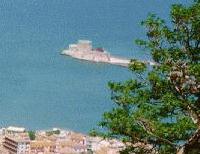 Epidaurus:
In a green valley full of springs and streams, 10 kilometres
on the west of the city of Epidaurus by the sea, the cult of
the waters was practiced since the mycenaean times. Whereas
the worship of Apollo-Maleatas continued at a temple on the
nearby mountain Kynortion, deep in the valley, near the sacred
springs, a new Sanctuary was built especially for the worship
of Asklepios. Soon the Sanctuary gained great importace and in
the fourth century BC, it was fully restored. At the same
time, on the slope of the mountain northeast from the temple,
a theatre was built, famous since that time for being the
prettiest of all the Greek theatres; this theatre is still
preserved in almost excellent condition. The theatere consists
of a circular orchestra of 20.28 metres diameter has a centre
altar of Dionysus. A small ditch (euripus) runs around its
perimeter, in order to collect the rainwater. The cavea has
the shape of a fan, with 34 rows of seats, divided into 12
sectors by scales holding approximately 6200 spectators.
Beyond the semicircular corridor (diazoma), at a later period,
there were added 21 new rows of seats with a capacity of
another 14000 spectators. The analogy between the number of
rows of the upper and lower diazomae is considered to be
mathematically "perfect". The first and the last row
of the lower part and the first of the upper part had seats
with backs and these seats were reserved for distinguished
citizens. A complicated set of relationships, largely based on
the theory of the golden cut, gave the theatre ideal aesthetic
harmony and almost perfect acoustics. The stage that rose
behind the orchestra, most of it lost, was supported by 12
Ionic pillars while at each end it had a jutting-out wing.
However, during the Hellenistic as well as the Roman period,
it underwent several changes that altered its original shape.
As it usually happens in Greek theatres, the two spaces
between the stage and the cavea (parodoi or passings) were
left open to the public due to great circulation. These were
adorned with two glorious entrances with Corinthian pillars.
Every year at this theatre there took place feasts in honour
of Asklepios, including musical and dramatic presentations. In
1954 the theatre was restored into its original shape and
since then it hosts every summer the productions of the
Epidaurus festival. Epidaurus:
In a green valley full of springs and streams, 10 kilometres
on the west of the city of Epidaurus by the sea, the cult of
the waters was practiced since the mycenaean times. Whereas
the worship of Apollo-Maleatas continued at a temple on the
nearby mountain Kynortion, deep in the valley, near the sacred
springs, a new Sanctuary was built especially for the worship
of Asklepios. Soon the Sanctuary gained great importace and in
the fourth century BC, it was fully restored. At the same
time, on the slope of the mountain northeast from the temple,
a theatre was built, famous since that time for being the
prettiest of all the Greek theatres; this theatre is still
preserved in almost excellent condition. The theatere consists
of a circular orchestra of 20.28 metres diameter has a centre
altar of Dionysus. A small ditch (euripus) runs around its
perimeter, in order to collect the rainwater. The cavea has
the shape of a fan, with 34 rows of seats, divided into 12
sectors by scales holding approximately 6200 spectators.
Beyond the semicircular corridor (diazoma), at a later period,
there were added 21 new rows of seats with a capacity of
another 14000 spectators. The analogy between the number of
rows of the upper and lower diazomae is considered to be
mathematically "perfect". The first and the last row
of the lower part and the first of the upper part had seats
with backs and these seats were reserved for distinguished
citizens. A complicated set of relationships, largely based on
the theory of the golden cut, gave the theatre ideal aesthetic
harmony and almost perfect acoustics. The stage that rose
behind the orchestra, most of it lost, was supported by 12
Ionic pillars while at each end it had a jutting-out wing.
However, during the Hellenistic as well as the Roman period,
it underwent several changes that altered its original shape.
As it usually happens in Greek theatres, the two spaces
between the stage and the cavea (parodoi or passings) were
left open to the public due to great circulation. These were
adorned with two glorious entrances with Corinthian pillars.
Every year at this theatre there took place feasts in honour
of Asklepios, including musical and dramatic presentations. In
1954 the theatre was restored into its original shape and
since then it hosts every summer the productions of the
Epidaurus festival.
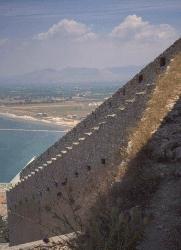 Tiryns:
After you've left Argos, and if you have time, stop in Tiryns. Since the buses run regularly
down the main road near the site it shouldn't be too long
between visits. The only thing to really see here
is the
acropolis,
but it shouldn't be missed. Take a guidebook since the
foundations of the palace
are confusing. You can still see the hearth, column
bases, and even a bath recessed into the floor in the royal
quarters. The entire fortress was inhabited from around
5000 B.C. on, and the most extensive constructions are
Mycenaean. The walls of the fortress are spectacular.
Huge pieces of rock are wedged together to form Cyclopean
walls
that surround the entire acropolis. Strabo tells us that seven Cyclopes helped to build these walls; I
guess we'll just have to take him at his word. Tiryns:
After you've left Argos, and if you have time, stop in Tiryns. Since the buses run regularly
down the main road near the site it shouldn't be too long
between visits. The only thing to really see here
is the
acropolis,
but it shouldn't be missed. Take a guidebook since the
foundations of the palace
are confusing. You can still see the hearth, column
bases, and even a bath recessed into the floor in the royal
quarters. The entire fortress was inhabited from around
5000 B.C. on, and the most extensive constructions are
Mycenaean. The walls of the fortress are spectacular.
Huge pieces of rock are wedged together to form Cyclopean
walls
that surround the entire acropolis. Strabo tells us that seven Cyclopes helped to build these walls; I
guess we'll just have to take him at his word.
From on top
of the palace you can get a great view on to Nauplio. The
entire complex seems very strange, rising up abruptly
from the plain just about a mile from the gulf. The
lower section of the fortress (seen to the left in the
picture) has now been closed off as has some of the upper
level due to some of the stones falling from their places. |